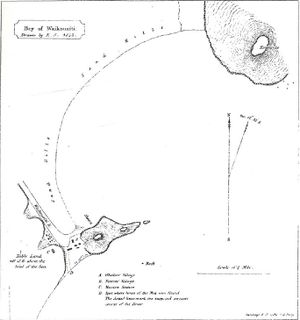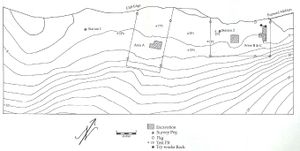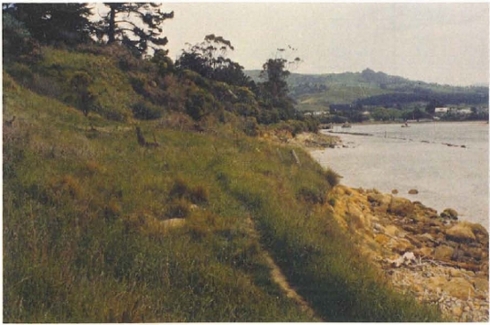Waikouaiti Whaling Station
The Waikouaiti Whaling Station (I43/66) is an early historic site located in New Zealand. It was established in 1837 by Long, Wright, and Richards and sold a year later to Johnny Jones. The whaling station served as a processing center for whale blubber and oil after the whales were captured and killed in the nearby harbor. As an archaeological site, the whaling station provides good evidence for the contact period between Europeans and the Māori, the indigenous Polynesian peoples of the area. Excavation was conducted in November 1992 by Matthew Campbell.
Contents
Location
| Waikouaiti whaling station is located in a town called Karitane at the mouth of the Waikouaiti River, 34km North of the city of Dunedin. The city itself is situated within the Otago Region of New Zealand. The river stretches into a salt water lagoon that empties into the sea. This area was deep enough for whales to come into the harbor and made the cliffs along the coast an ideal location for an industrial area focused on whaling. | <googlemap lat="-45.638287" lon="170.654755" zoom="13" height="300" scale="yes" controls="large">
-45.641943, 170.657135, Karitane, Otago, New Zealand </googlemap> |
History
| The Waikouaiti Whaling Station was originally established in 1837 by a group of men named Long, Wright, and Richards. After their company failed the following year, it was sold to Johnny Jones. Jones is accredited for bringing Europeans to the region and establishing the city of the same name that is present today. In 1840, the first settlers arrived aboard the Magnet. About 100 Europeans were living and farming in the area at the time. Traditional domesticates included chicken and sheep. In addition, 120 Maori lived in a nearby pa, a village or settlement. Archaeology of this area has shown that contact occurred between the groups. Historical accounts of the station describe agricultural fields and cottages along the shore where most of the workers lived. The station continued on through the 1870s during the whaling revival when the Maori built a ship of their own. |
Excavation
Historical sketches show that the industrial whaling area was to the Northern side of Huriawa Peninsula. Descriptions claim the try-works was further toward the isthmus in several sheds and the whaling shears were closer to the harbor. The site was first surveyed in 1844 by Davison. His sketches formed the basis of the work that Campbell and his crew conducted in 1992.
| The site itself was surveyed as part of the October/November 1990 site survey done of whaling stations along the southern coast and includes only the industrial center. Being along the coast, the site had been subjected to harsh weather and was beginning to erode. The cliffs were slumping down, distorting stratigraphy and leaving voids in the earth. As excavation began, the location of the try-works was based on a 1899 photograph taken by Maus. They were thought to be up on a terrace, about 50 x 15m in size and 1.5m from the edge, on a cliff at the northeast end of the site. However, this proved to not be the case. The signal staff was located on a high point of the peninsula. Around the area was historic and prehistoric terracing, but this was distorted and also enhanced by the erosion and slumping occurring in the area. It was also located in an area enclosed by the Huriwa Pa in the 18th century. In November 1992 excavation of the site began. The area was mapped with a theodolite and electronic distance meter. The excavation itself was split into three areas. |
Area A
Area A was established at the location of two possible building terraces. A 2x2m unit was initially opened up at the beginning of excavation. The top layer turned out to be a large area of midden with both European and Maori cultural artifacts. Faunal material included fishbones, especially barracouta (Thyrsites atun) and possibly groper (Polyprion oxygeneios). Shell fish found included blue mussel (Mytilis edulis aoteanus), cockle (Chione stutchburyt) and pipi (Paphies australis). All of these species are common to the area and normally found at Maori sites. Other faunal remains included those of one lamb. An additional 2x2m unit was opened that revealed slump in the stratigraphy. This proved to be be a characteristic of the erosion occuring in the area and no cultural layers were found.
Area B
Area B was thought to be the location of the try-works based on a 1899 photograph of the area. It was characterized by pits, depressions, and ditches all thought to be part of the try-works. A 1x1m unit was opened about 90m southwest of the shears on the coast near what was assumed to be rocks from the try-works. This covered the edge of the terrace in the area. With excavation, more rocks were found in association with the ones already known. These were caversham sandstone that had been heavily eroded by the salty water. Campbell and his crew expected to find an ashy lens filled with charcoal as a lot of heat was needed to process the blubber and oil from the whales. However, no charcoal was found. The team came to the conclusion that the area could not have been the location of the try-works as they and the 19th century photographer presumed. Sandstone would not have been suitable for the sheds mentioned in historic descriptions because it would have melted under the intense heat.
Area C
Area C consisted of six test pits and one trench near the suspected try-works rocks. A 50x15cm piece of zinc sheeting was recovered still nailed to a piece of wood. Most likely it was used as roofing for the sheds that were described as being in the area. A 40cm barrel band was also found in association with another nail. Another 2x2m unit was opened up to increase the amount of area the trench covered. Campbell and his crew found a dark, almost black soil layer with charcoal, fish, shellfish, bird, and sheep remains. Layer 1 of the stratigraphy was dark brown and clearly a cultural level from the historic period. Nails and nuts were found along with two stone flake tools, one of chalcedony (which showed use-wear) and another of silcrete. Layer 2 was a fill layer of clay in dark soil and clearly was associated with cultural activity. Layer 3 consisted of charcoal over a thin layer of sand. This resembles the soil found at another whaling station called Wellers Rock try-works. However, the charcoal at this station was very different than that found at Waikouaiti. This difference could be due to the poor preservation and erosion at the site.
Summary of Results
Sources
- "North of Dunedin," Te Ara: The Encyclopedia of New Zealand. Te Ara
- Campbell, Matthew 1993. The Excavation of Waikouaiti Whaling Station (I43/66); A report to the New Zealand Historic Places Trust. University of Orago.
External Links
- Prickett, Nigel 2002. "The Archaeology of New Zealand Shore Whaling" Auckland War Memorial Museum.
- Biography of Johnny Jones Dictionary of New Zealand Biography


